18 Worst Weeds in Raleigh and How to Get Rid of Them
BY LYDIAN PINE | JUNE 28TH, 2019 | LAWN CARE, NORTH CAROLINA, RALEIGHSmall weeds indicate larger problems in your Raleigh lawn. The most effective prevention method is understanding the pesky weeds so you can eradicate them. Discover the 18 worst weeds in Raleigh and how to get rid of them.
- Why Are Weeds Bad for Your Raleigh Lawn?
- Ways to Control Weeds in Your Raleigh Yard
- 18 Worst Weeds in Raleigh
- Bull Thistle
- Chickweed
- Dallisgrass
- Dandelion
- Doveweed
- Goosegrass
- Green Foxtail
- Ground Ivy
- Japanese Stiltgrass
- Large Crabgrass
- Lespedeza
- Mock Strawberry
- Plantain
- Purple Nutsedge
- Ragweed
- Spotted Spurge
- Virginia Buttonweed
- White Clover
Why Are Weeds Bad for Your Raleigh Lawn?
Weeds drain nutrients from your lawn, signifying underlying problems like low nitrogen, imbalanced pH, and thinning turf. Maintain a healthy lawn with routine maintenance, watering, and fertilization schedules, and the weeds won’t stand a chance. Here are some reasons weed control is important:
- Weeds steal vital nutrients, water, and sunlight from your turfgrass and plants.
- They camouflage and spread pests and diseases.
- The longer you let weeds live rent-free in your yard, the harder they are to control.
Ways to Control Weeds in Your Raleigh Yard
There are two ways to control weeds in your lawn: chemical treatments and hand pulling. Pulling weeds by hand is the safest removal method, but it isn’t always the best. Be sure to identify the type of weed you are dealing with before selecting your removal method.
Hand Weeding
Experts agree hand weeding is just as important as chemical removal methods. You should aim to weed your yard and garden weekly or bi-weekly. Here are some tips to keep in mind:
- Remove weeds while they are young before they have bloomed or developed complex root systems
- Be sure to remove the entire weed, including roots, rhizomes, tubers, or bulbs
- Use a screwdriver or dandelion fork to help remove weeds with a taproot, like dandelions or spotted spurge
Weed Control Chemical Treatments
- Pre-emergent herbicide: Kills seeds before germination, preventing weeds from popping up in your yard
- Post-emergent herbicide: Targets weeds you can see, disrupting growth and killing them
- Iron-based herbicide: Specifically targets broadleaf weeds
18 Worst Weeds in Raleigh
1. Bull Thistle (Cirsium vulgare)
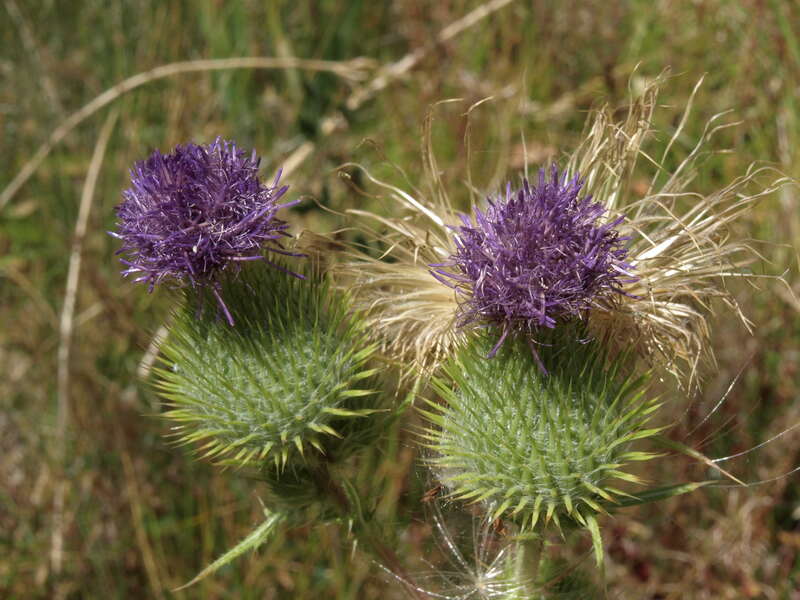
Photo Credit: Jim Morefield / Flickr / CC BY-SA 2.0
Also known as spear thistle or common thistle, bull thistle is a prickly biennial plant with tall, branching stems that grow up to five feet tall and sprout downy purple flowers. Find specimens in pastures, meadows, and along roadsides. Bull thistle grows in sunny areas, forming dense thickets that choke other plants.
Though it’s a noxious weed, bull thistle is beneficial to pollinators like bees and butterflies. It is fairly easy to control when compared to other species of thistle and responds well to hand removal and post-emergent herbicide.
- Plant type: Broadleaf biennial
- USDA hardiness zone: 3-10
- Habitat: Adaptable
- Danger: Moderate; prickly flowers, mildly toxic to humans and livestock
- Removal method: Post-emergent herbicide
2. Chickweed (Stellaria media)
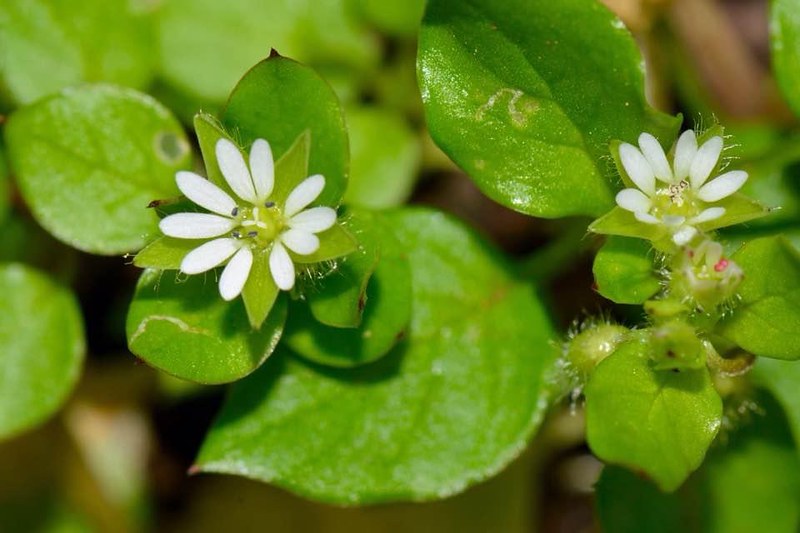
Photo Credit: Jean and Fred Hort / Flickr / CC BY 2.0
Chickweed is a low-growing, spreading, broadleaf annual with shallow roots. It forms dense patches, crowding out turfgrass and other plants. Chickweed withstands high mow heights and thrives in moist, shady areas.
Specimens bloom conspicuous clusters of white, star-shaped flowers for one to two months between February to September. Control this pesky shade-loving weed by treating your lawn with a pre-emergent herbicide or hand-pulling specimens that pop up.
- Plant type: Broadleaf annual
- USDA hardiness zone: 4-11
- Habitat: Moist, shady lawns and gardens, especially near buildings
- Danger: Low; edible but large quantities cause stomach irritation in humans
- Removal method: Pre-emergent herbicide, hand removal
3. Dallisgrass (Paspalum dilatatum)
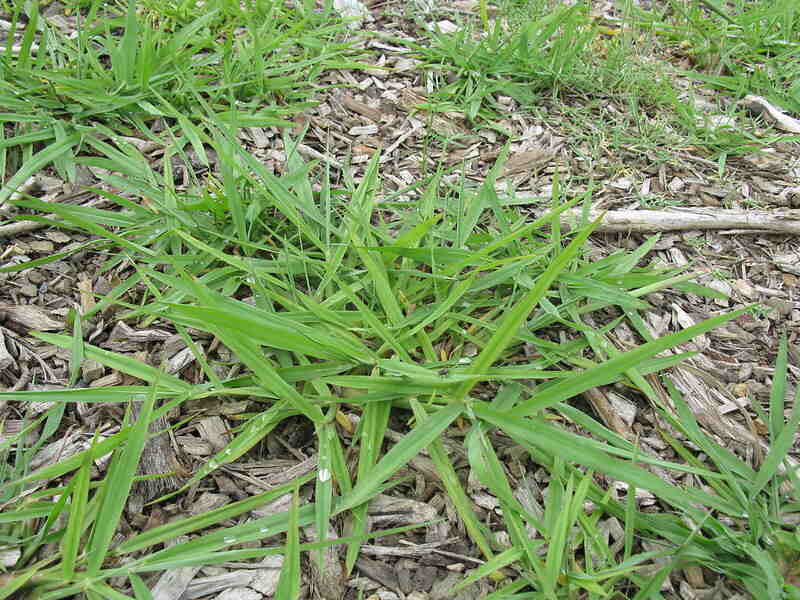
Photo Credit: Harry Rose / Flickr / CC BY 2.0
Dallisgrass is an invasive bunchgrass and common perennial weed in Raleigh lawns. It grows quickly and has a coarse, hairy texture with tall stalks and cone-shaped flowers. Prevent dallisgrass by maintaining a dense lawn and applying a pre-emergent herbicide in the spring.
- Plant type: Perennial grass
- USDA hardiness zone: 6-9
- Habitat: Adaptable; prefers moist disturbed habitats like lawns, pastures, paths, and sidewalks
- Danger: Moderate; non-toxic but susceptible to ergot fungus, which is toxic to livestock and horses
- Removal method: Routine lawn maintenance, pre-emergent herbicide, hand removal
4. Dandelion (Taraxacum officinale)
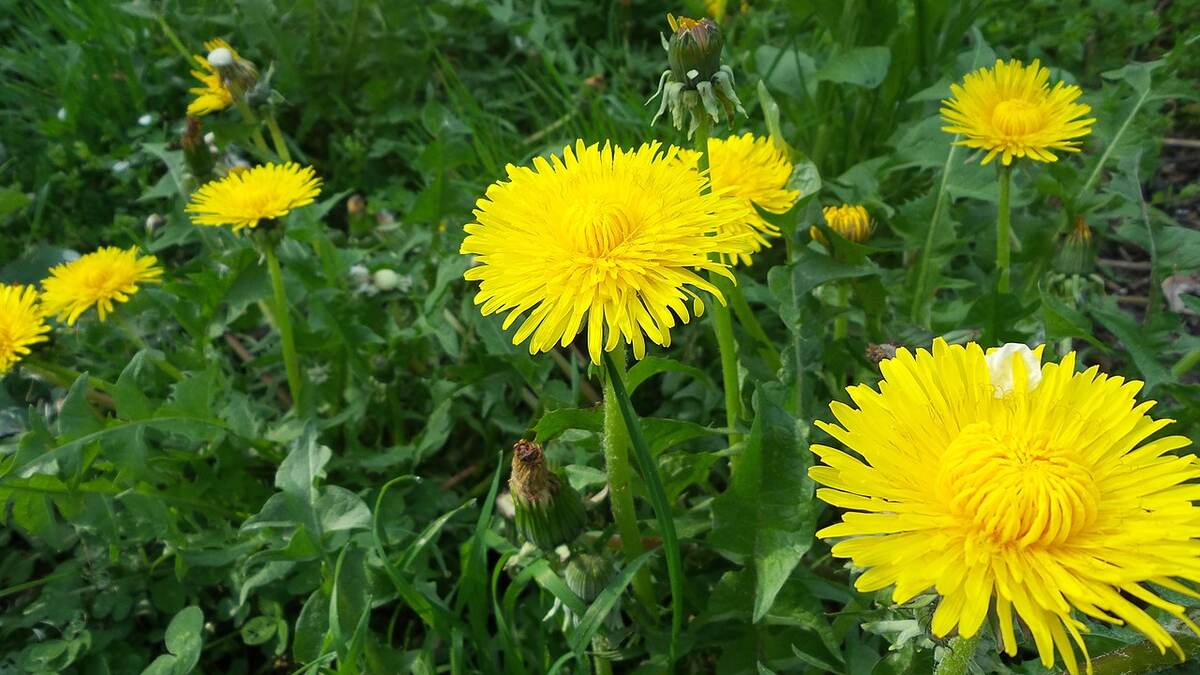
Photo Credit: Sunasce007 / Wikimedia Commons / CC BY-SA 4.0
Dandelions are perennial weeds with a thick, fleshy stem that secretes a white, milky sap when broken. Perhaps the most recognizable weed of all time, its bright yellow flowers mature, drying out into spherical clusters of white puffballs composed of parachute-like seeds. Dandelions live up to two years and thrive in disturbed turf. Their peak blooming season is from February to March.
Prevent dandelions by maintaining your landscape with regular mowing, fertilizing, and watering to encourage dense growth. Dandelions have long taproots that penetrate the soil and respond well to hand pulling. Additionally, control specimens with a post-emergent broadleaf herbicide.
- Plant type: Broadleaf perennial
- USDA hardiness zone: 3-10
- Habitat: Adaptable; prefer disturbed habitats like lawns, pastures, paths, and sidewalks
- Danger: Low; edible but may cause irritation in some people
- Removal method: Hand removal, dandelion fork, post-emergent broadleaf herbicide
5. Doveweed (Murdannia nudiflora)
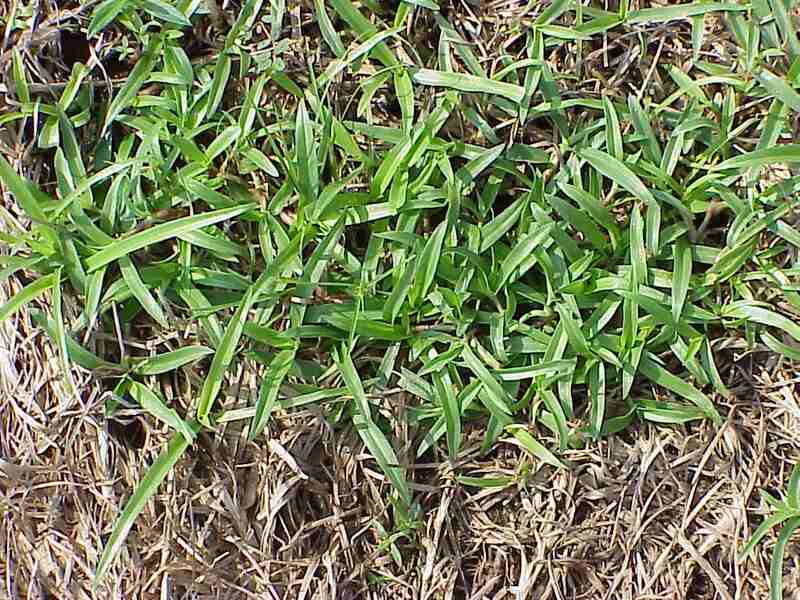
Photo Credit: George3819 / Wikimedia Commons / CC BY-SA 3.0
Doveweed is a summer annual weed that germinates during hot weather, appearing from late May to August. It resembles dense mats of grass but develops short stalks with clusters of purple flowers as it matures. Doveweed thrives in moist soils and full sun.
Prevent doveweed with proper turf maintenance, beginning in the spring with pre-emergent herbicide applications. Practice good drain management and target specimens that appear with a post-emergent herbicide.
- Plant type: Broadleaf annual
- USDA hardiness zone: 7-10
- Habitat: Poorly-drained, moist turfgrass, garden beds, containers, walkways, or ditches
- Danger: Low; may cause dermatitis in dogs
- Removal method: Pre-emergent herbicide, post-emergent herbicide, and proper drain management
6. Goosegrass (Eleusine indica)
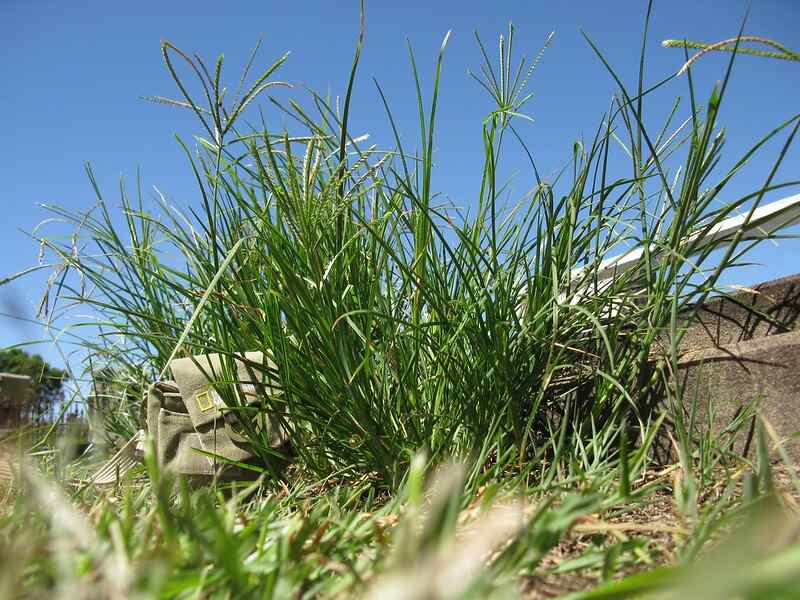
Photo Credit: Harry Rose / Flickr / CC BY 2.0
Goosegrass thrives in compact soil, making its home in short home lawns, athletic fields, and golf courses. Specimens compete with warm and cool-season turfgrasses. Goosegrass is dark green with a low, bunching growth habit that makes it impenetrable to most mowing. Prevent goosegrass by maintaining healthy soil and applying pre-emergent herbicides.
- Plant type: Annual grass
- Location: 3-9
- Habitat: Adaptable; prefer compacted soil
- Danger: Non-toxic; edible
- Removal method: Hand pulling, pre-emergent herbicide, post-emergent herbicide
7. Green Foxtail (Setaria viridis)
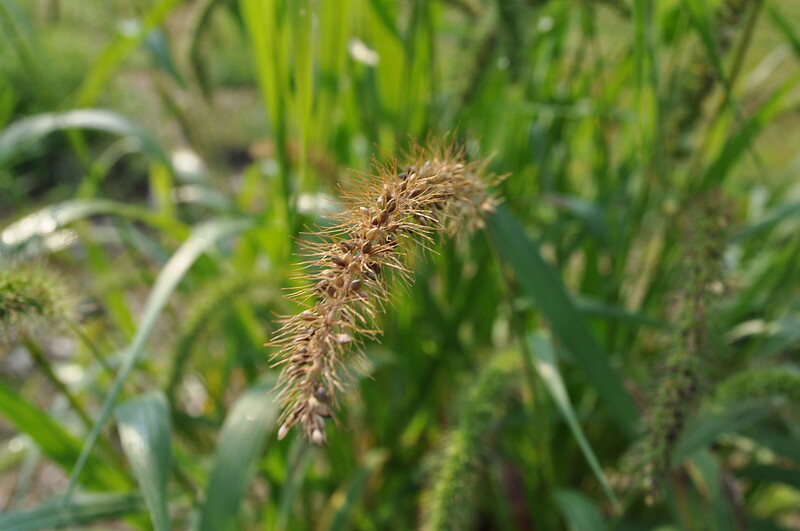
Photo Credit: NY State IPM Program at Cornell University / Flickr / CC BY 2.0
Green foxtail is a bright green annual grass with fuzzy seed heads that resemble animal tails or wheat. Specimens adapt to most soil types and thrive in well-drained sites. Prevent green foxtail with proper lawn maintenance and routine applications of pre-emergent herbicides. It responds well to both hand removal and post-emergent herbicides.
- Plant type: Annual grass
- USDA hardiness zone: 5-9
- Habitat: Well-drained, moist clay, sand, or shallow rocks
- Danger: Irritating seeds; harmful to horses, dogs, and cats
- Removal method: Hand removal, pre-emergent herbicide, post-emergent herbicide, and routine lawn maintenance
8. Ground Ivy (Glechoma hederacea)
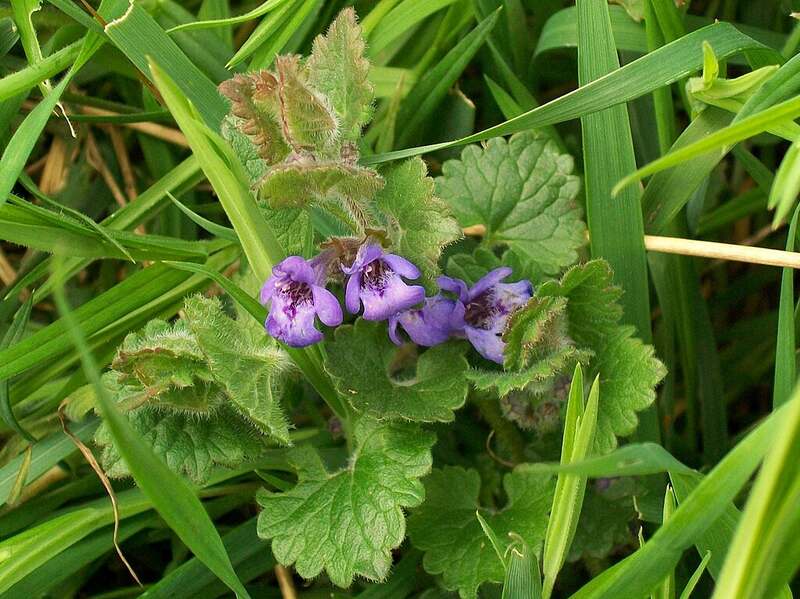
Photo Credit: AnemoneProjectors / Wikimedia Commons / CC BY-SA 2.0
Ground ivy, or creeping Charlie, is a broadleaf perennial weed. Its leaves are round with scalloped edges, and specimens produce clusters of blue flowers. Ground ivy thrives in moist, shaded locations and some homeowners use its leaves to make medicinal tea, soups, or jams.
Control ground ivy with proper drain management, aeration, and applications of pre-emergent herbicide. Apply a post-emergent herbicide to control specimens that emerge. The broadleaf perennial blooms in early spring and typically goes dormant in the hot summer months.
- Plant type: Broadleaf perennial
- USDA hardiness zone: 5-9
- Habitat: Moist, shaded locations
- Danger: Moderate; toxic to horses in large quantities
- Removal method: Post-emergent herbicide, regular fertilization schedule
9. Japanese Stiltgrass (Microstegium vimineum)
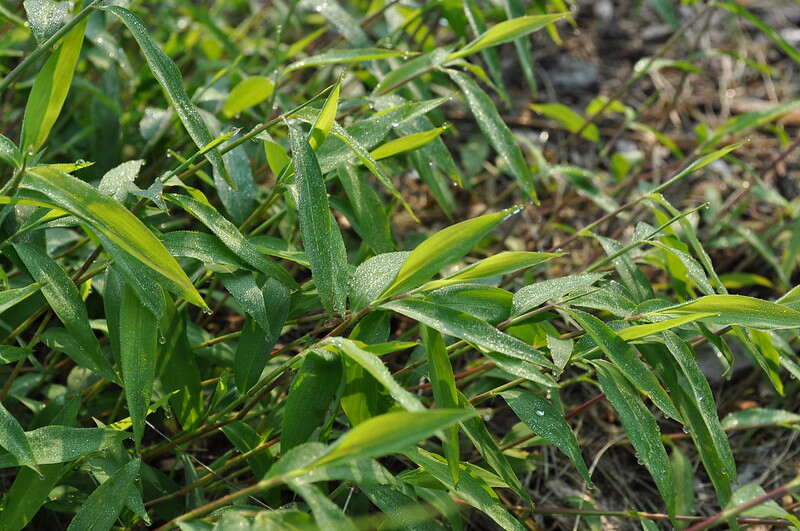
Photo Credit: NY State IPM Program at Cornell University / Flickr / CC BY 2.0
Japanese stiltgrass thrives in moist, shaded areas but adapts to most conditions. Specimens resemble delicate bamboo plants with asymmetrical leaves. The broadleaf perennial weed grows up to three feet tall, creating a habitat for ticks. Remove Japanese stiltgrass by hand or with applications of post-emergent herbicide.
- Plant type: Broadleaf perennial
- USDA hardiness zone: 5-9
- Habitat: Moist, shaded locations
- Danger: Moderate; toxic to horses in large quantities
- Removal method: Post-emergent herbicide, regular fertilization schedule
10. Large Crabgrass (Digitaria sanguinalis)
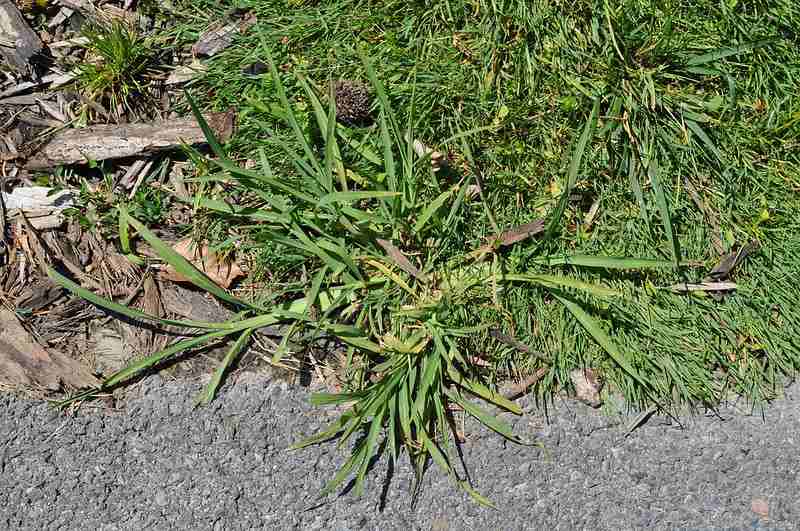
Photo Credit: NY State IPM Program at Cornell University / Flickr / CC BY 2.0
Large crabgrass is one of the most common weeds found in Raleigh yards. It is low-growing and resistant to mowing. Large crabgrass resembles light-green clumps of grass and is commonly mistaken for tall fescue.
Large crabgrass germinates in the spring and appears throughout the summer. Control specimens with routine maintenance, including applications of pre-emergent herbicide. Post-emergent herbicide works to control specimens that emerge.
- Plant type: Annual grass
- USDA hardiness zone: 3-11
- Habitat: Sparse, disturbed habitats like thin lawns, gardens, vacant lots, roads, and grass paths
- Danger: None
- Removal method: Pre-emergent herbicide, post-emergent herbicide, and routine lawn maintenance
11. Lespedeza (Kummerowia striata)
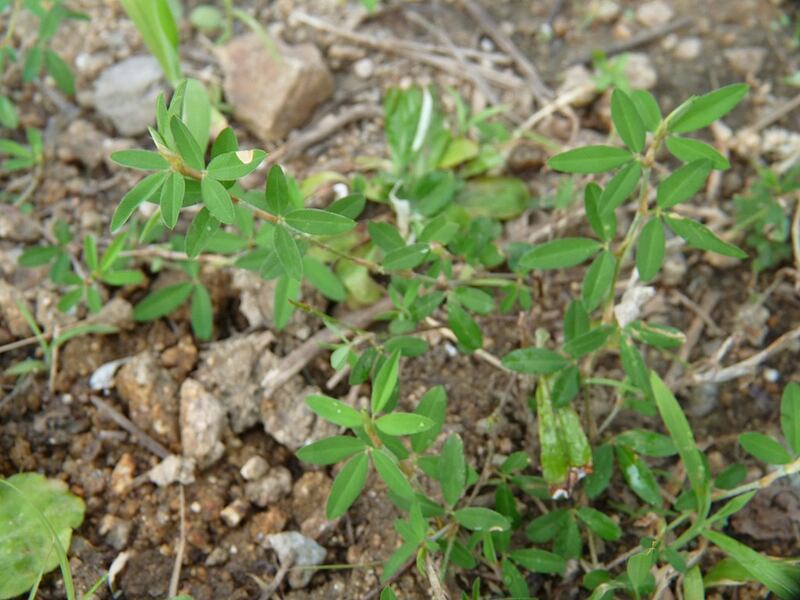
Photo Credit: Show_ryu / Wikimedia Commons / CC BY-SA 3.0
Lespedeza, also known as Japanese clover, is a summer annual weed with small, oval leaves similar to clover. The stems become woody as specimens mature and pink or purple flowers bloom. It is a low-growing broadleaf weed that thrives in dry, disturbed turf.
Control lespedeza with proper lawn maintenance and applications of pre-emergent herbicide. Remove emerged specimens using a dandelion fork or post-emergent herbicide.
- Plant type: Broadleaf annual
- USDA hardiness zone: 4-9
- Habitat: Sunny, well-drained, disturbed habitats with clay, loam, sand, or shallow rock
- Danger: None
- Removal method: Hand removal, dandelion fork, pre-emergent herbicide, post-emergent herbicide
12. Mock Strawberry (Potentilla indica)
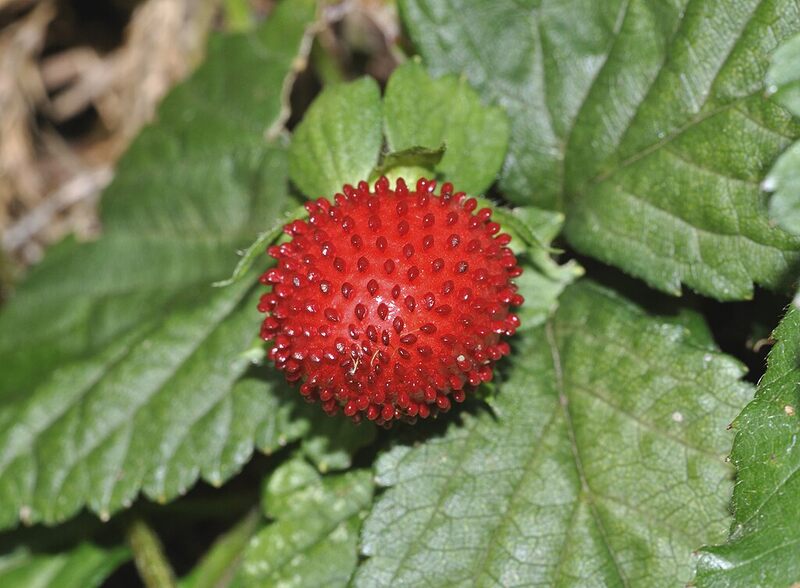
Photo Credit: Quartl / Wikimedia Commons / CC BY-SA 3.0
Mock strawberry, or Indian strawberry, disguises itself as a strawberry plant. However, this broadleaf perennial invades healthy plants and turfgrass, robbing them of vital nutrients. Its fruit is small and tasteless, and specimens bloom yellow flowers. Mock strawberry has a spreading growth habit and thrives in moist, sunny locations.
Prevent mock strawberries by improving drainage, aerating, and practicing proper watering techniques. Remove emerged specimens by hand or treat them with a post-emergent broadleaf herbicide.
- Plant type: Broadleaf perennial
- USDA hardiness zone: 5-9
- Habitat: Moist, sunny locations
- Danger: None; edible
- Removal methods: Hand removal and post-emergent broadleaf herbicide
13. Plantain (Plantago major)
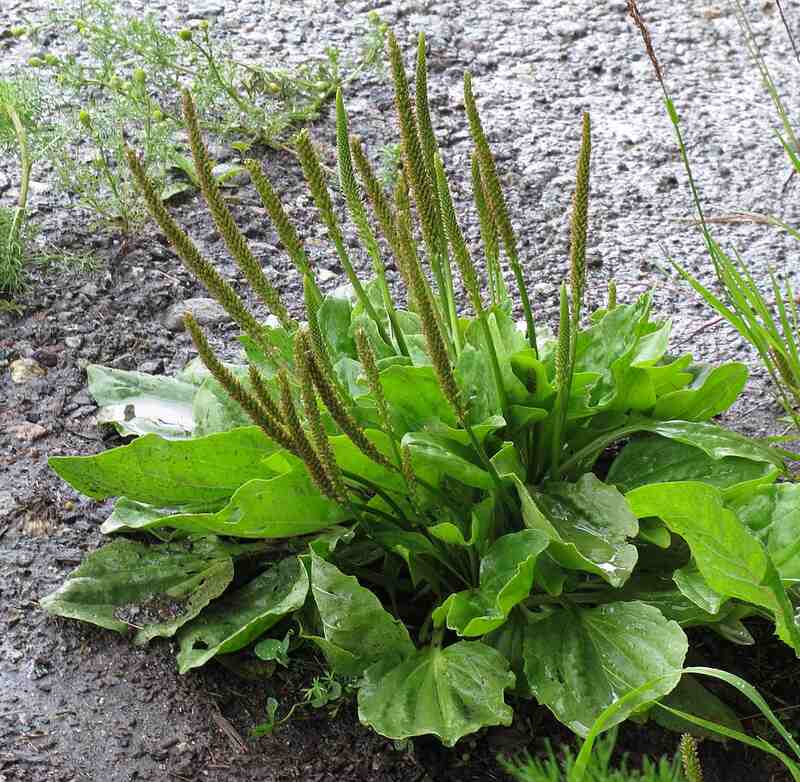
Photo Credit: Robert Flogaus-Faust / Wikimedia Commons / CC BY 4.0
Plantain, not to be confused with the delicious fruit, is a broadleaf perennial weed that lives for more than two years in compacted soils with full sun and good drainage and stands up to heavy foot traffic. Plantain produces waxy, hairy leaves and tall flowers. Prevent plantain with proper lawn maintenance and applications of pre-emergent herbicide.
- Plant type: Broadleaf perennial
- USDA hardiness zone: 3-9
- Habitat: Well-drained, rich, compacted clay or loam
- Danger: None; used medicinally
- Removal method: Pre-emergent herbicide
14. Purple Nutsedge (Cyperus rotundus)
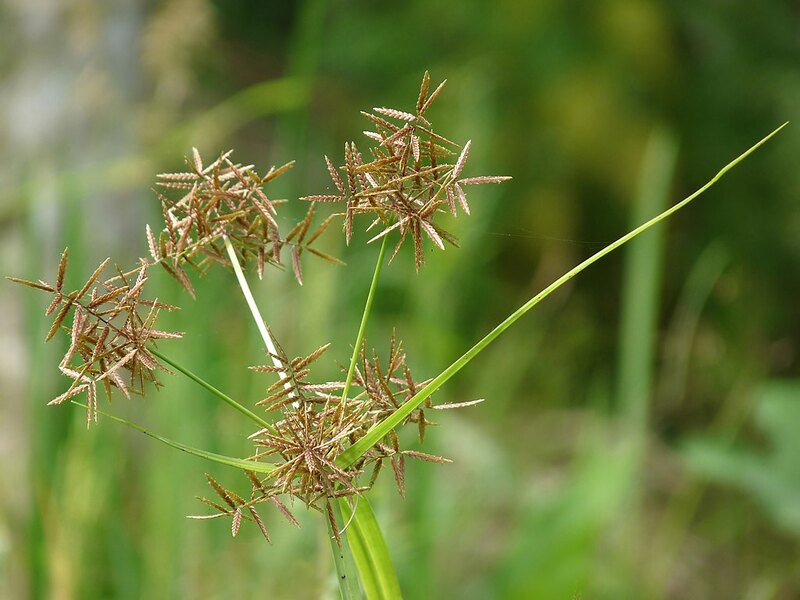
Photo Credit: © 2009 Jee & Rani Nature Photography / Wikimedia Commons / CC BY-SA 4.0
Purple nutsedge, also known as nutgrass, is an aggressive perennial weed that resembles grass. Specimens have v-shaped stems and thick, stiff leaves. Purple nutsedge produces purple seed heads and thrives in temperate and tropical regions.
Specimens prefer moist, flooded clay, loam, or sand and full sun. Prevent purple nutsedge with proper turfgrass maintenance. Target emerged specimens with a broadleaf herbicide.
- Plant Type: Sedge perennial
- USDA hardiness zone: 4-9
- Habitat: Moist, poorly drained soil
- Danger: None; used medicinally
- Removal method: Post-emergent herbicide
15. Ragweed (Ambrosia psilostachya)
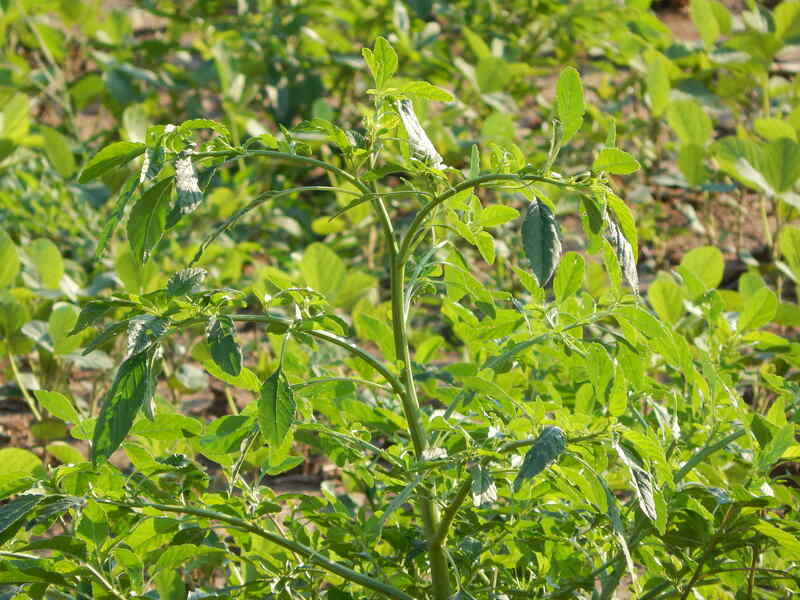
Photo Credit: United Soybean Board / Flickr / CC BY 2.0
Also known as American wormwood, ragweed is a broadleaf annual weed that releases large amounts of pollen. Find it growing in poor soils with full sun. Ragweed has coarse, hairy stems and lobed leaves. Prevent the allergy-inducing pest with applications of a pre-emergent herbicide, proper lawn maintenance, and broadleaf herbicide.
- Plant Type: Broadleaf annual
- USDA hardiness zone: 6-10
- Habitat: Adaptable; prefer sunny, disturbed habitats like lawns, pastures, and paths with heavy soils
- Danger: High; produces large amounts of pollen
- Removal method: Hand removal, mowing, and broadleaf herbicide
16. Spotted Spurge (Euphorbia maculata)
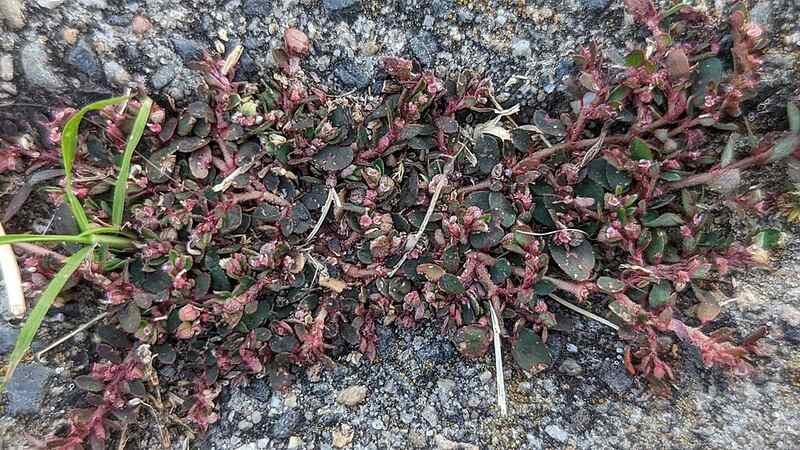
Photo Credit: Michel Langeveld / Wikimedia Commons / CC BY-SA 4.0
Spotted spurge thrives in North Carolina’s summer heat. It is low-growing, forming dense mats that choke turfgrass. Spotted spurge varies in color from reddish-green to dark green and produces small white flowers. The broadleaf annual thrives in sunny, dry habitats like lawns, pastures, and sidewalk cracks.
Remove spotted spurge by hand and prevent the pesky weeds using a pre-emergent herbicide in the spring and fall. Post-emergent herbicide works to control emerging specimens.
- Plant Type: Broadleaf annual
- USDA hardiness zone: 3-9
- Habitat: Adaptable; prefer sunny, dry, disturbed habitats like lawns, pastures, paths, and sidewalks
- Danger: Low; irritating milky sap
- Removal method: Pre-emergent, post-emergent, hand removal
17. Virginia Buttonweed (Diodia virginiana)
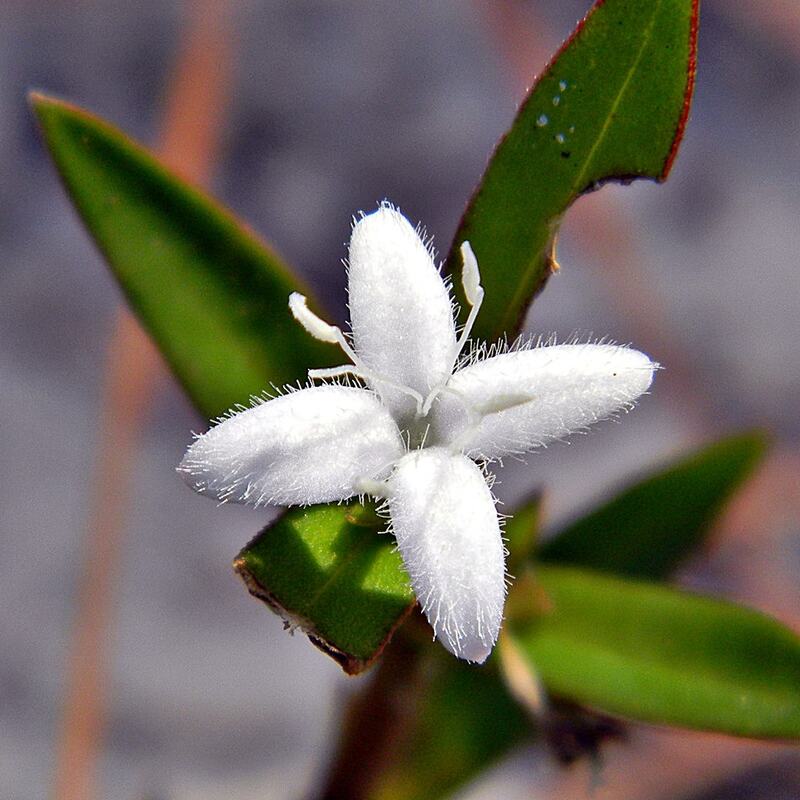
Photo Credit: Bob Peterson from North Palm Beach, Florida, Planet Earth! / Wikimedia Commons / CC BY-SA 2.0
Virginia buttonweed is a perennial weed native to the Southeast. It resembles common wildflowers and blooms from summer through fall. Virginia buttonweed lives for more than two years, thriving in rich, moist soils. Control specimens with applications of pre-emergent herbicide and hand removal.
- Plant type: Broadleaf perennial
- USDA hardiness zone: 6-9
- Habitat: Moist, rich loam or clay
- Danger: Low
- Removal method: Hand removal, pre-emergent, and post-emergent herbicide
18. White Clover (Trifolium repens)
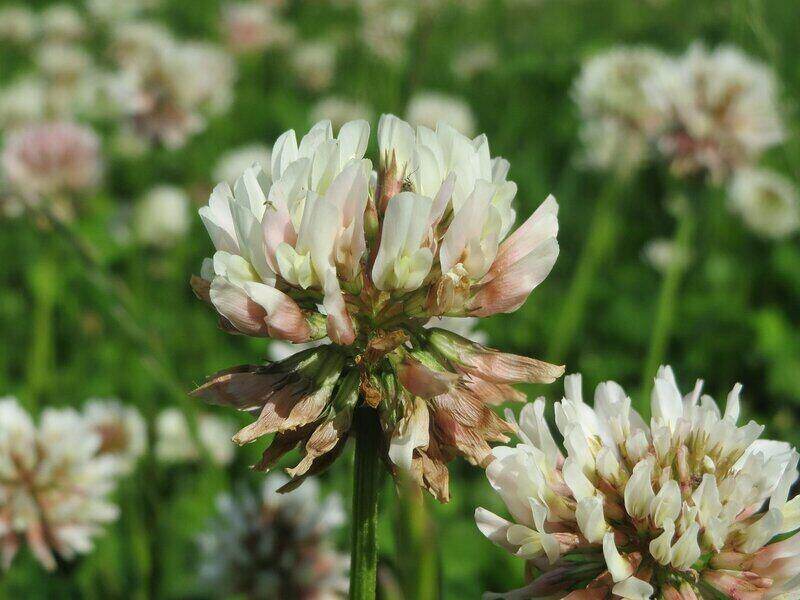
Photo Credit: WikimediaImages / Pixabay / License
White clover is a perennial weed with an aggressive growth habit. Specimens survive most mowing. Find white clover in fields and moist soil with partial shade. Farmers typically use the perennial as a cover crop to balance nitrogen levels and prevent soil erosion. It also provides forage for livestock. Prevent white clover by hand pulling specimens or applying post-emergent herbicide.
- Plant Type: Broadleaf perennial
- USDA hardiness zone: 3-9
- Habitat: Nitrogen-poor, grassy habitats
- Danger: Toxic; damaged leaf tissues release cyanide
- Removal method: Hand removal, pre-emergent herbicide, and post-emergent herbicide
FAQ About the Worst Weeds in Raleigh
Selective herbicides control specific weeds or weed families.
Non-selective herbicides are typically more potent than selective herbicides. They work on many weeds, including grassy and broadleaf. However, they also wipe out good vegetation and turfgrass. These heavy-duty herbicides are best left to the professionals.
Raleigh’s unique climate suits both warm and cool-season grass cultivars, including:
Warm-season grasses:
● Bermudagrass
● Centipedegrass
● St. Augustinegrass
● Zoysiagrass
Cool-season grasses:
● Kentucky bluegrass
● Fine fescue
● Perennial ryegrass
● Tall fescue
Professional Weed Control for Your Raleigh Landscape
Prevent weeds by maintaining your Raleigh landscape. Unfortunately, fertilizing, mowing, and watering can be time-consuming. Let Wikilawn connect you with a local lawn care pro, so you can spend more time enjoying the Old North State.
Main Photo Credit: PxFuel